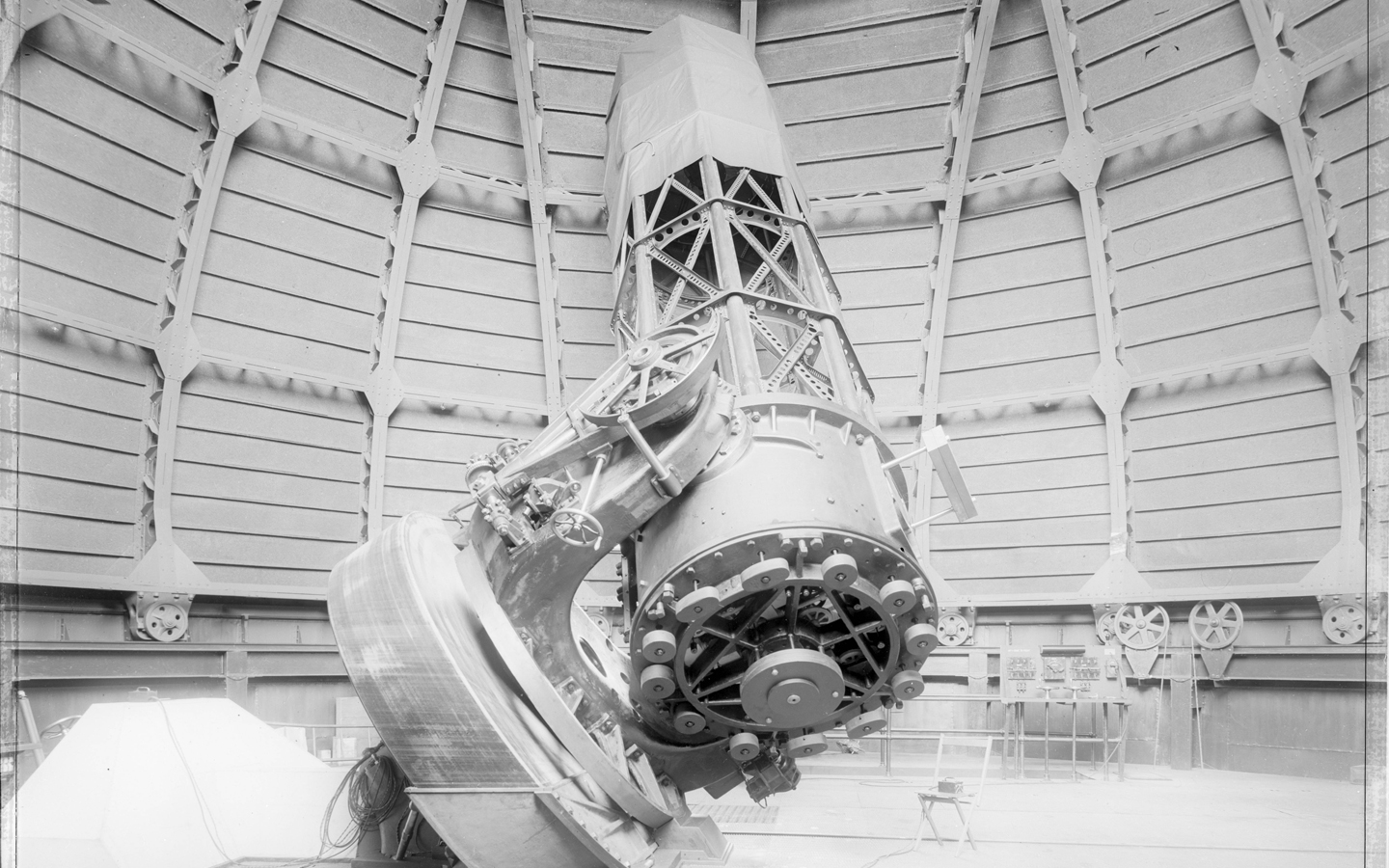
Goldstone Deep Space Communications Complex
TEXT FARIDA AMAR
VISUAL JEFF LEAVITT
I always tell everyone in Los Angeles I grew up in the middle of nowhere, that place where you stop to get gas on your way to Vegas. The Mojave Desert. Most people laugh awkwardly and ask, “what was it like growing up out there?” Usually, they can’t even imagine the idea of living in the desert full-time. Aside from the gorgeous landscape, the Integratron, and the Salton Sea—which attract plenty of glamping tourists each year—we have wolves and coyotes, sometimes even bobcats wandering nearby. Sometimes when it rains on one side of the road, it is dry and sunny on the other. We have old choo-choo trains that still blow their horns to say hello when they see you outside their little conductor station window. We have horses; not just as pets, but as transportation. And, we have ghost towns left over from the California Gold Rush; plenty of them.
Goldstone is one such ghost town. Gold was supposedly found there as early as the 1880s, but the first recorded account of it was October 1915; by 1916, the two guys who had been mining there alone for ten years grew into a mining camp of 150 men. They had a lodging house and a daily delivery of mail, and for $5 they could take a ride over to the nearest town, Barstow. After a water mill was established for the camp in 1917, they expanded to nine buildings, ten houses, and a restaurant that could serve up to 150 guests. They abandoned the title “camp” and grew into the Goldstone Milling Company, providing enough work for a small mining town. They even talked about putting in a telephone line! But the telephone line never made it, because by the end of 1917, there were only three miners left. This growth, decline, and eventual closure of the mining operation took place all within one year, and to this day, no one knows why. Apparently, the Barstow newspapers went “missing,” virtually erasing any historical records of the towns brief legacy. Goldstone was one of the last of a series of boomtown gold rushes; their little post office, Goldbridge, officially closed on August 15, 1918.
Nothing happens. Wolves roam. Crows die. Buildings deteriorate.
Goldstone established the first deep space communication technology to be built in the world. According to the Goldstone website, “The location was selected because it is remote from power lines and free of interference from commercial radio and television transmitters, which can impede reception of the very weak signals sent by the spacecraft.” Apparently, the middle of nowhere is an ideal place to grow up if you’re a deep space antenna.
In 1958, NASA began construction on the Pioneer Deep Space Station (DSS-11) antenna, the first to be installed at Goldstone. DSS-11 became the prototype antenna for the Deep Space Network and went on to track a variety of NASA missions—including all Pioneer spacecraft, the Echo Balloon projects, Ranger, Lunar Orbiter, Surveyor, Apollo, Helios, Mariner, Viking, and Voyager. A Manned Space Flight wing was then built at the Pioneer site to support the crewed space flights of the Apollo program. DSS-11 was officially closed in 1981 and declared a National Historic Monument as the first deep space antenna in the Deep Space Network (DSN) in 1985. Aside from the Amboy Crater eruption 10,000 or so years ago, the Goldstone Deep Space Communications Complex is the most exciting thing to ever happen in the Mojave Desert.
In 1965, two more deep space communication complexes were built, one in Canberra, Australia, and one in Madrid, Spain. Together, these three stations form NASA’s Deep Space Communications Network (DSN). Each of these stations are located 120 degrees apart to form a complete circle around Earth (120 + 120 + 120 = 360 degrees) and work together to track and communicate with spacecraft from low Earth orbit to the edge of the solar system and beyond. The strategic placement of these sites permits constant communication with spacecraft as our planet rotates—before a distant spacecraft sinks below the horizon at one DSN site, another site can pick up the signal and resume communication.
The DSN helped Mission Control stay in touch with the Apollo astronauts. It relayed the first televised images of Neil Armstrong stepping onto the Moon in 1969. During Apollo 13, when limited battery power and an inability to use the high-gain antennas meant the crew was unable to communicate with NASA’s Manned Space Flight Network, the largest DSN antenna, along with Australia’s Parkes Observatory radio telescope, was critical in bringing the astronauts home. In 1965, the DSN received images from NASA’s Mariner 4 spacecraft, the first close-ups of Mars. In 1974, DSN returned Mariner 10 images of Mercury. When NASA’s twin Voyager spacecraft buzzed by Jupiter, Saturn, and Neptune, DSN brought home the first close-ups of these planets and their rings and moons. DSN also carried the data conveying the famous self-portrait of Earth known as the “Pale Blue Dot.” It continues to monitor the Voyager spacecrafts’ entries into interstellar space.
Goldstone has three types of antennas: one 70-meter antenna, seven 34-meter antennas, and one 26-meter antenna. The 70-meter is the granddaddy, measuring 230 feet in diameter, weighing nearly 3,000 tons, and is really the only one that can track spacecraft traveling tens of millions of kilometers beyond Earth’s surface. The 70-meter antenna, called DSS-14 or the “Mars Antenna,” was the first of the giant antennas designed to receive weak signals and transmit very strong ones far out into space. When it became operational in 1966, it featured a 64-meter-wide (210-foot) dish—in 1988, it was upgraded to 70 meters to enable the antenna to track Voyager 2 as it encountered Neptune. This antenna picked up the Mars name from its first task: tracking the Mariner 4 spacecraft, which had been lost by smaller antennas after its historic flyby of Mars in 1965. The surface of the dish is maintained to a precision of within one centimeter across its 41,400-square-foot surface, because any deformations would interfere with the antenna’s operations. The Mars antenna has supported missions that include Pioneer, Cassini, and the Mars Exploration Rovers. It received Neil Armstrong’s famous transmission from Apollo 11: “That’s one small step for a man, one giant leap for mankind.”
The 34-meter antennas are 111 feet in diameter and are made as high-efficiency (HEF), beam waveguide antennas. The beam waveguide version includes five precision radio frequency mirrors that reflect radio signals along a tube from the antenna to a below-ground room. This design allows the sensitive electronics at the center of the antenna dish to be in a climate-controlled equipment room, shielding them from weather and heat. After the landing of the Viking spacecraft on Mars in 1976, the principal thrust of solar system exploration shifted to missions to the outer planets; i.e., Jupiter, Saturn, Uranus, and Neptune. DSS-13 (aka “Venus”) provided our first radar observations of the planet Venus and was converted from a 26-meter antenna to a 34-meter antenna in 1979. DSS-15 (aka “Uranus”) was built in 1984 and named for its support of the Voyager 2 encounter with the planet Uranus in 1986. DSS 27 and DSS 28 (aka “Gemini”) are twin antennas originally built by JPL for the Army and transferred to NASA in 1994. Their first mission was the Solar Heliospheric Observatory (SOHO), a cooperative mission between NASA and the European Space Agency (ESA).
The 26-meter antenna, DSS-16 (aka “Apollo”), is 85 feet in diameter and is used for smaller tasks, such as tracking Earth-orbiting spacecraft located between 100 and 620 miles above the planet. It was originally built to support the Apollo missions, which sent human explorers to the Moon between 1967 and 1972. The maximum tracking speed for the 26-inch antenna is three degrees per second, which is the equivalent of tracking one full rotation of an Earth-orbiting spacecraft every two minutes.
Goldstone also plays well with others and can achieve what is called antenna arraying. This means Goldstone, Canberra, and Madrid can combine signals from multiple antennas to function as one large unit. Arraying is helpful in improving deep space communications signals, as spacecraft transmissions become very weak when traveling across vast interplanetary distances. The Deep Space Network first used arraying for missions in the early 1970s, and then employed the technique to aid the 1979 Voyager encounters at Jupiter, the Pioneer 11 encounter with Saturn, and the Voyager encounters with Saturn in 1980 and 1981. By the time Voyager 2 flew by Uranus in 1986, the DSN was combining signals from up to four antennas; the Neptune encounter three years later utilized signals from Australia’s Parkes Radio Telescope, the Canberra complex, and the 27 antennas of the Very Large Array (VLA) in New Mexico. When the high-gain antenna of the Galileo mission to Jupiter (1996–1997) incurred damage while in space, the DSN arrayed up to five antennas from the three DSN tracking facilities. The result for Galileo was improved data return by a factor of three, compared to that of a single 70-meter (230-foot) antenna. Arraying, plus advances in data compression and encoding techniques, helped make Galileo so successful that its mission was extended to more than a dozen years of valuable observations of Jupiter and its moons.
Even though tracking spacecraft with great precision in deep space is wildly exciting, the antennas at Goldstone are also used to check in on spacecraft health and safety, send coded instructions to robotic probes to do space-chores and maintenance, talk with astronauts on crewed spacecraft, and take images and video for us back on Earth. Scientists at Goldstone also spend their time observing asteroids and the interiors of planets and moons.
Goldstone antennas also perform telemetry, collecting and distributing information for scientists to sift through, as well as offering a massive amount of materials used in what is called Radio Science (which is literally the exact opposite of radio silence). Radio Science challenges the theory of relativity by using any changes in radio signal transmissions and receipts to conduct experiments that provide information on the real “middle of nowhere” which, as it turns out, is actually much, much farther away than the Mojave Desert.
In the 1860s, James Clerk Maxwell’s equations illustrated that electromagnetic radiation is associated with electricity and magnetism, and could exist at any wavelength. This provided the platform for the study of Radio Astronomy. Radio Astronomy is one kind of Radio Science conducted at the deep space communications complexes, using radio frequencies sent and received by the antennas to detect changes in radio waves that respond to the radiation emitted by astronomical objects. This includes observations and discoveries regarding stars, other galaxies, radio galaxies, quasars, pulsars, and masers. The Goldstone Apple Valley Radio Telescope (GAVRT) is a reconfigured 34-meter antenna used for teaching Radio Astronomy to K–12 students. The GAVRT program educates students to calibrate this antenna (known as Deep Space Station-28) and collect and distribute science data. Recognized as part of the science team, students collaborate with NASA scientists working on the Jupiter/Juno Project, black hole patrol, solar patrol, and the Search for Extraterrestrial Intelligence (SETI). NASA then uses the data collected and analyzed by the students in their studies of the solar system.
Deep space is a vague term that generally describes anything outside the influence of our Sun; however, Goldstone covers everything within our solar system and up to tens of billions of miles beyond. The continuous work being done around the clock at Goldstone since December 24, 1963 is critical to our ability to explore our universe, and to this day, provides the most accurate information using the most sensitive scientific equipment and telecommunications systems in the world. From the first challenge to walk on the Moon to our current objective to inhabit Mars, the Deep Space Network is absolutely essential. Currently, there is no alternative option available to communicate with spacecraft from Earth. In some way, it would feel a lot like growing up in the middle of nowhere forever. Because the Mojave offers a mixed perspective of unlimited possibility and endless time, it seems to me to be a perfect place for some of our best scientists to ask the question that has driven every explorer: “What’s next?”




